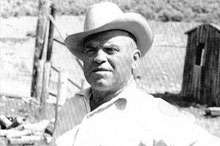No products in the cart.
The Visionary

Ira Perrine Saves the Day
By Erin Anchustegui
Some of my fondest memories are of riding my horse through the sagebrush on our family ranch, which sat between Shoshone and Richfield. Recently, when I went back to visit our ranch, I flashed on images of my father walking down a dirt path next to the Little Wood River wearing a white shirt, straw cowboy hat, and a shovel perched on his right shoulder.
Water was an essential ingredient to irrigating the land and keeping our cows and sheep hydrated in hot summers. I wondered how an arid desert region like the Magic Valley, not naturally suitable for farming and ranching, had so much water. So I set about doing some research and discovered how much my grandfather, Eusebio, had in common with a famous Idahoan, Ira B. Perrine.
Eusebio, a Basque sheepherder, left Spain with only a few possessions and came to Idaho to make a new life in 1918. His father had wanted him to be an engineer in Spain, but he had different aspirations. Arriving on the train in Shoshone, he stayed in a Basque boarding house with other newcomers until he found work. He gradually migrated up to the Wood River Valley to work in the mines.
In the early 1880s, Ira Burton Perrine left Indiana for Idaho. Eschewing his family’s directives to become a minister and spend a lifetime preaching, he sought to make his fortune mining in Idaho. By the late 1800s, the state already had gained a national reputation for its wealth in mineral ore. Gold brought the first white settlers here and gold helped to establish the Idaho Territory in 1863. As gold resources dried up, the search for other minerals began.
This content is available for purchase. Please select from available options.
Purchase Only
Purchase Only

